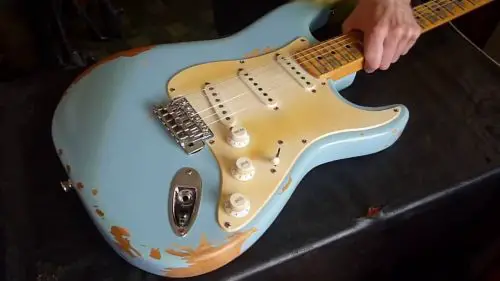Guitars with poly finish are very durable but can still crack if given enough force and will wear out and turn yellow after some time.
Although that takes a long time. I expect a poly guitar to start turning yellow after at least 3 years.
There are usually two sides of people when talking about cracked guitars – those who want to preserve their guitar to new for as long as possible.
And those who purposely crack and wear out their guitars to achieve that ‘aged’ look – also known relicing.
Regardless of which one you are, this article should be suitable for you.
I am going to discuss poly finish in general – how durable they are, how to relic a poly finish guitars and how to fix a poly guitar that’s been accidentally cracked.
Let’s dive in.
Does Poly Finish Crack?
Poly finish is extremely durable and will not crack or wear out with regular use. However, accidentally dropping it or applying a strong enough force can definitely crack a guitar with poly finish.
If you want to preserve your guitar look, then you have to be careful. Regularly using the poly finish guitar will not crack it – but make sure you don’t drop it.
If you want to relic a poly finish guitar – then good news, it’s actually possible. It’s just a little harder to do than nitro finish guitar, because poly finish has layers that are much thicker.
I will discuss how to relic a poly finish guitar a little later.
Will Poly Finish Guitar Wear & Yellow Over Time?
Poly finish guitars can wear out and turn yellow over time (although it takes longer than nitro finish guitars).
The yellowing effect is made even faster if you expose the guitars with cigarette smoke or exposure to direct sunlight for long periods of time.
If you want to prevent yellowing, you should keep your guitars inside a case when not in use and don’t ever smoke cigarettes around the guitar (or any smoke in general).
If you want to accelerate the yellowing effect, I don’t suggest you expose the guitars to direct sunlight. Instead, just play your guitar like you normally would. Store the guitar on a guitar stand when not in use (instead of a guitar case).
Over time, the yellowing will happen to your poly guitars. It just won’t happen that quickly like a nitro guitar – I expect at least 6 months to 1 year before you notice anything.
Related article: Will White Guitars Turn Yellow? 5 Ways To Prevent
How Do You Relic a Poly Finish Guitar?
Trying to relic a poly finish guitar is challenging because it’s much thicker and more durable than a nitro finish guitar. However, It is possible with the right method and expectation.
The trick to relic a poly finish guitar is to scrape off only the top layer finish. You stop scraping once you reach the clear coat. Trying to remove the clear coat takes too much time and it will not look good.
Typically a poly guitar is made of below layers (from inner layer to outer layer):
- Wood
- Clear coat
- Top layer finish
The clear coat layer on a poly finish guitar is extremely thick – it can be as thick as 1cm and is very challenging to remove.
I also do not recommend removing the clear coat layer – it’s there to protect the guitar wood from mold and termites. Removing the clear coat layer can significantly damage your guitar. Do not do it!
Here is the list of tools you need to relic a poly finish guitar:
- Extremely sharp craft knife
- Eye goggles or glasses
- Sand paper
Here is the steps to relic a poly finish guitar:
- Google search a good looking relic guitar as reference
- Put on goggles. Important because the poly finish guitars will create flakes that can get in your eyes when you relic them.
- Start scraping the top layer finish from your guitar body (follow the scratches and nicks from your reference)
- Rub sandpaper on areas that you want to look worn
After all of this is done, you should have a finished relic guitar that looks something like below.
I recommend you only relic the guitar body. Trying to relic the neck, head stock or bridge area could be damaging to your guitar – avoid this.
I personally would relic the areas on the guitar body where I interact with the most (so it looks natural). For example, the sides of the guitar body where my arm rests.

Relicing poly guitars
How To Fix Cracked Poly Guitar
To fix a cracked poly guitar, you should apply a thin super glue into the cracked area and let it seep in and dry out. Once dried, use sandpaper to soften the rough edges and it should be good.
You can never truly restore a cracked guitar. My best advice is to actually live with it. It’s normal for a guitar to get some damage and wear out as you use it for a long time. It actually gives some character.
Some people love the look and I think you could embrace it too. Trying to fix a cracked guitar may make it even look worse – so proceed with caution.
Make sure you wait till the super glue dries out before trying to wipe it off or rub it with sandpaper.
Guitar Finish Polyester Vs Polyurethane
Polyester guitar finish is thicker than a polyurethane finish. Polyester holds its appearance over a long time and is the new standard finish on guitars. Both polyester and polyurethane are equally durable.
If you are a regular guitarist that wants a guitar to look new for as long as possible, then the polyester is the best choice.
If you are a guitarist that wants to age your guitar and have that worn look after some time, then a polyurethane guitar is the next in line after nitro guitars.
Both polyester and polyurethane guitars are equally durable and do not get scratched or dings easily.
If you don’t really care about the look of your guitar, then both polyester and polyurethane are good. They are durable, last a long time and sound the same.
Should You Relic Your Guitar?
You should definitely try relicing your guitar if you are into that look. Nitro guitars are generally easier to relic because they are less durable than poly.
If you know you want that aged relic look, then you can get a nitro guitar and relic it yourself. You will not be able to completely replicate an actual aged guitar – but relicing a guitar yourself should look pretty similar.
Just be careful when you relic a guitar – and make sure you don’t damage it. Relicing a nitro guitar is much easier and there are plenty of tutorials online.
Relicing a poly guitar is much harder and the steps I described above are the only ways I know of that work.
Poly guitars are meant to last long and look new for as long as possible. Thus, it’s much harder to relic them.





